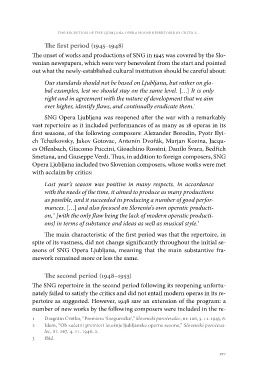Page 399 - Weiss, Jernej, ur. 2019. Vloga nacionalnih opernih gledališč v 20. in 21. stoletju - The Role of National Opera Houses in the 20th and 21st Centuries. Koper/Ljubljana: Založba Univerze na Primorskem in Festival Ljubljana. Studia musicologica Labacensia, 3
P. 399
the reception of the ljubljana opera house repertoire by critics ...
The first period (1945–1948)
The onset of works and productions of SNG in 1945 was covered by the Slo-
venian newspapers, which were very benevolent from the start and pointed
out what the newly-established cultural institution should be careful about:
Our standards should not be based on Ljubljana, but rather on glo-
bal examples, lest we should stay on the same level. […] It is only
right and in agreement with the nature of development that we aim
ever higher, identify flaws, and continually eradicate them.1
SNG Opera Ljubljana was reopened after the war with a remarkably
vast repertoire as it included performances of as many as 18 operas in its
first seasons, of the following composers: Alexander Borodin, Pyotr Ilyi-
ch Tchaikovsky, Jakov Gotovac, Antonín Dvořák, Marjan Kozina, Jacqu-
es Offenbach, Giacomo Puccini, Gioachino Rossini, Danilo Švara, Bedřich
Smetana, and Giuseppe Verdi. Thus, in addition to foreign composers, SNG
Opera Ljubljana included two Slovenian composers, whose works were met
with acclaim by critics:
Last year’s season was positive in many respects. In accordance
with the needs of the time, it aimed to produce as many productions
as possible, and it succeeded in producing a number of good perfor-
mances. […] and also focused on Slovenia’s own operatic producti-
on, 2 [with the only flaw being the lack of modern operatic producti-
ons] in terms of substance and ideas as well as musical style.3
The main characteristic of the first period was that the repertoire, in
spite of its vastness, did not change significantly throughout the initial se-
asons of SNG Opera Ljubljana, meaning that the main substantive fra-
mework remained more or less the same.
The second period (1948–1953)
The SNG repertoire in the second period following its reopening unfortu-
nately failed to satisfy the critics and did not entail modern operas in its re-
pertoire as suggested. However, 1948 saw an extension of the program: a
number of new works by the following composers were included in the re-
1 Dragotin Cvetko, “Premiera ‘Sneguročke’,” Slovenski poročevalec, nr. 106, 3. 11. 1945, 6.
2 Idem, “Ob začetni premieri letošnje ljubljanske operne sezone,” Slovenski poročeva-
lec, nr. 267, 4. 11. 1946, 2.
3 Ibid.
397
The first period (1945–1948)
The onset of works and productions of SNG in 1945 was covered by the Slo-
venian newspapers, which were very benevolent from the start and pointed
out what the newly-established cultural institution should be careful about:
Our standards should not be based on Ljubljana, but rather on glo-
bal examples, lest we should stay on the same level. […] It is only
right and in agreement with the nature of development that we aim
ever higher, identify flaws, and continually eradicate them.1
SNG Opera Ljubljana was reopened after the war with a remarkably
vast repertoire as it included performances of as many as 18 operas in its
first seasons, of the following composers: Alexander Borodin, Pyotr Ilyi-
ch Tchaikovsky, Jakov Gotovac, Antonín Dvořák, Marjan Kozina, Jacqu-
es Offenbach, Giacomo Puccini, Gioachino Rossini, Danilo Švara, Bedřich
Smetana, and Giuseppe Verdi. Thus, in addition to foreign composers, SNG
Opera Ljubljana included two Slovenian composers, whose works were met
with acclaim by critics:
Last year’s season was positive in many respects. In accordance
with the needs of the time, it aimed to produce as many productions
as possible, and it succeeded in producing a number of good perfor-
mances. […] and also focused on Slovenia’s own operatic producti-
on, 2 [with the only flaw being the lack of modern operatic producti-
ons] in terms of substance and ideas as well as musical style.3
The main characteristic of the first period was that the repertoire, in
spite of its vastness, did not change significantly throughout the initial se-
asons of SNG Opera Ljubljana, meaning that the main substantive fra-
mework remained more or less the same.
The second period (1948–1953)
The SNG repertoire in the second period following its reopening unfortu-
nately failed to satisfy the critics and did not entail modern operas in its re-
pertoire as suggested. However, 1948 saw an extension of the program: a
number of new works by the following composers were included in the re-
1 Dragotin Cvetko, “Premiera ‘Sneguročke’,” Slovenski poročevalec, nr. 106, 3. 11. 1945, 6.
2 Idem, “Ob začetni premieri letošnje ljubljanske operne sezone,” Slovenski poročeva-
lec, nr. 267, 4. 11. 1946, 2.
3 Ibid.
397


